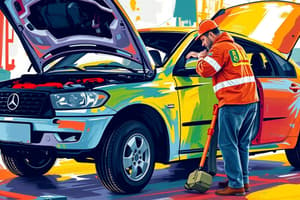Podcast
Questions and Answers
What is the primary composition of toxic smoke?
What is the primary composition of toxic smoke?
- Water vapor and oxygen
- Nitrogen and helium
- Carbon monoxide, hydrogen cyanide, and chlorine (correct)
- Oxygen and carbon dioxide
During which stage of a fire is dense black smoke visible?
During which stage of a fire is dense black smoke visible?
- Growth
- Incipient
- Decay
- Fully Developed (correct)
What is indicated by smoke emanating under pressure from cracks around windows or doors?
What is indicated by smoke emanating under pressure from cracks around windows or doors?
- Fire is in the decay stage
- Fire is in the incipient stage
- Fire is in the growth stage
- Fire gases are filling the fire area (correct)
What is the rating of a fire extinguisher that can extinguish 60 ft² of Class B fire?
What is the rating of a fire extinguisher that can extinguish 60 ft² of Class B fire?
What is the characteristic of the agent in a 4A 60B C fire extinguisher?
What is the characteristic of the agent in a 4A 60B C fire extinguisher?
What is the volume of water equivalent to the agent in a 10A 80B C fire extinguisher?
What is the volume of water equivalent to the agent in a 10A 80B C fire extinguisher?
What is the characteristic of smoke during the decay stage of a fire?
What is the characteristic of smoke during the decay stage of a fire?
What is indicated by smoke-stained or blackened windows?
What is indicated by smoke-stained or blackened windows?
What is the characteristic of rollover during a fire?
What is the characteristic of rollover during a fire?
What is the volume of the agent in a 4A 60B C fire extinguisher?
What is the volume of the agent in a 4A 60B C fire extinguisher?
Flashcards are hidden until you start studying
Study Notes
Mine Rescue
- Every mine must maintain a mine rescue team to ensure the safety of workers and property on mine sites.
- The mine rescue team must be trained to respond to incidents at surface and underground mining operations.
Incident Response
- Upon arriving at the incident scene, stage response vehicles at a safe distance to avoid exposure to electrical hazards.
- Isolate the vehicle for a period of time at a safe distance to avoid injury.
- Eliminate the hazard before digging.
Fire Safety
- Firefighters are responsible for their safety and the safety of their team, and may also need to tend to casualties in need of assistance.
- Fire safety equipment includes:
- Pressure gauge
- Carrying handle
- Discharge lever with pin/tamper seal
- Hose
- Extinguishing agents (water, AFFF, dry powder, dry chemical, etc.)
Extinguishing Agents
- Water:
- Non-toxic, plentiful, and efficient
- Converts from liquid to steam, absorbing heat in the process
- Good range and penetration
- Absorbs more heat per volume than any other agent
- AFFF:
- Does not leave a residue
- Non-freezing
- Limited range
- Affected by wind
- Dry Powder:
- Can be hazardous if used in a confined or unventilated space
- Cold shock to electrical equipment
- Dry Chemical:
- Limited cooling effect
- Leaves a residue
- Can be corrosive
- Multi-Purpose Dry Chemical:
- Leaves a residue
- Limited range
- Limited cooling effect
- Class A Foam:
- Leaves a residue
- Will freeze
- Requires selection of correct foam for the fire application
Fire Stages
- Incipient: early stages of a fire
- Growth: fire spreads rapidly
- Fully Developed: fire at its peak
- Decay: fire begins to decline
Toxic Smoke
- Made up of various gases produced during combustion
- Examples: carbon monoxide, hydrogen cyanide, and chlorine
- Recognition signs:
- Dense black smoke
- Fire gases filling the fire area
- Rollover visible
- Little or no visible flame
- Smoke emanating under pressure from cracks
- Smoke drawn back in
- Smoke exiting in puffs or intervals
- Black smoke becoming dense grey yellow
- Smoke-stained or blackened windows
Studying That Suits You
Use AI to generate personalized quizzes and flashcards to suit your learning preferences.




